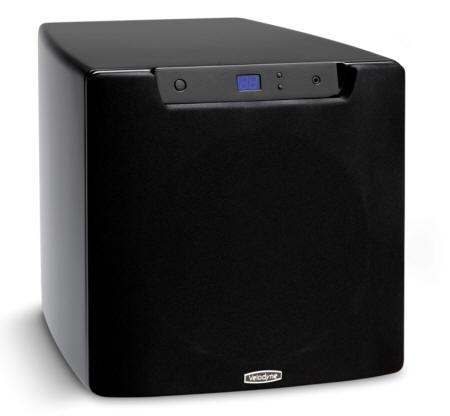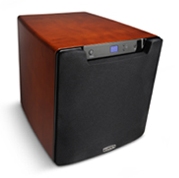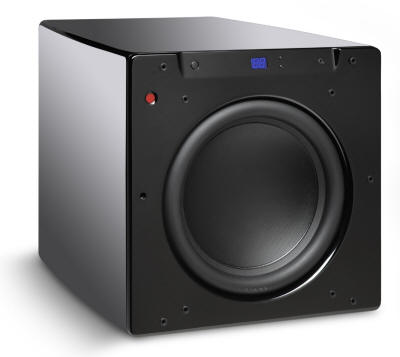Adjusting the controls on a subwoofer for best performance takes time and patience. It is always interesting to see ads for used subwoofers appear on the Web stating “only a week old” or “barely broken in”. These almost always identify a dissatisfied owner. I would bet that the owner did not take the time to 1) play a lot of music to break in the woofer driver; and 2) set the low-pass frequency and subwoofer volume controls correctly for optimal performance. I have set up about a dozen different subwoofer models, including a few that I built, in my systems over the years. I suggest that if you can determine the final settings by ear in less than two weeks then you are an unusually gifted subwoofer installer. The Velodyne Optimum-12 subwoofer makes this task far easier than many other subwoofers.

Velodyne has been making powered subwoofers for over 25 years. The upper models in the extensive product line use a servo (feedback) circuit that corrects non-linear errors which significantly reduces distortion while protecting the driver and amplifier if the performance limits are exceeded. You can’t blow them up by playing the 1812 Overture at high volume levels or by inviting King Kong into your living room. The new Optimum series replaced the well received SPL Series and sits just below the top tier Digital Drive models in Velodyne’s product line. The Optimum-12 has a list price of $1800 and is available in piano black or gloss cherry finish. I have the latter finish and find it very handsome, the reddish cherry contrasting elegantly with the black fascia. The Optimum series also includes 8″ and 10″ models. Among many other features, they include a 7-band equalization and room correction system with a set up program that is completely automatic. When you initially install the sub, connect the supplied microphone, push a button on the sub, and in a couple of minutes the sub adjusts its frequency response and corrects for anomalies in your room’s bass acoustics. It just doesn’t get any easier.
Adding to the feature list is a digital readout of the current low-pass crossover frequency setting. This setting is changed with a knob on the back of the sub. The display can also show the sub’s volume setting. These numerical indicators are hugely valuable to me as I can make note of these settings, change other components in my system, and very easily go back to a previously installed preamplifier or main speakers by simply dialing in the old settings. It takes just a minute to have perfect settings again. Since a difference of just one Hertz in the crossover frequency setting or just one number in the volume setting can ruin a perfect blend with the main speakers, these digital readouts are, at least for me, “must have” features. (Digital readouts in a subwoofer? Yes, I’m spoiled!) Another very helpful setup tool, included with Optimum subs, is a remote control that can change the volume of the sub, select mute, and adjust the phase from your listening seat.
The Optimum-12’s small remote control has several other useful features, such as enabling you to turn off the display or quickly check settings. The frequency response is 21-120 Hz (+-3dB). The 12” driver has a huge 21.6 pound (9.8kg) magnet which is driven by a 1200 Watt RMS cool running internal power amplifier. The overall weight is a manageable 49 pounds, and the size is a compact 15.25”H x 14.9”W x 18.5”D. It has a signal-sensing auto turn-on feature so you never have to bother to turn it on or off. Velodyne offers a confidence inspiring 5 year warranty on the driver and a shorter 3 years on the electronics. The removable grille is best left off for critical listening.
The subwoofers – I used these in pairs – for comparison are the $2800 JL Audio fathom f112. Other components included Marantz MA-9S2, Nuforce Reference 9 V2 SE and the new, incredibly musical Jones Audio PA-M300 amplifiers; Dali Euphonia RS-3, Merlin TSM-MMe and YG Acoustics Kipod stand mounted speakers; various preamplifiers; a custom Windows 7 computer using the outstanding Prism Orpheus Digital Interface; SOTA Cosmos IV turntable with a Triplanar VII u2 tonearm and Miyajima Shilabe moving coil cartridge. Interconnects are Mogami; speaker cables are Element Apollo and Audience Au24 e; power cords included Audience PowerChord e, Element Stealth “es”, PS Audio PerfectWave AC-10 and AC-12.
Having a system with smaller main speakers and powered subwoofers allows one to position each for best performance. In my room, the subs are positioned very close to and exactly parallel with the front wall. They sit just inside the positions of the main speaker stands. The stands are about 1-1.5 meters from the front wall. This positioning allows the best bass coupling to the room, and also the best imaging from the main speakers.
As mentioned above, break-in is critical to loosen up the suspension and realize the full resolution of any subwoofer. Plan on 200 hours of use as a start, and up to 500 hours or more depending on loudness and type of music. As with most subwoofers, the Optimum-12s offer a high-pass filter to limit low bass signals being sent to your main speakers. I never use a subwoofer’s high-pass filter in my audio-only system, feeling that the benefit – greater clarity in the midrange from being relieved of the low bass signal – does not outweigh the negative impact of having the filter and additional cabling in the circuit. “Two steps forward and one step back” is not a philosophy I employ in my audio system. If the main speakers are not up to the challenge of handling (but not necessarily reproducing) the full frequency signal, then they are replaced with a more capable model. In this mode, the subwoofer’s low-pass crossover is adjusted to fill in the bass that the main speakers are missing. For the speakers used in this review, all sealed box models, the setting was usually around 60 Hz.

Sealed box main speakers have significant advantages for use with subwoofers. Their phase shift at the bottom of the bass range is much less than a ported speaker which certainly makes it more likely that one will achieve a satisfactory blend with a subwoofer. Their slower rolloff also can give a wider acceptable tolerance for non-optimal crossover settings on the subs. If you already have some ported speakers that you like, you could simply plug the port with a towel. This is entirely reversable and will not void the warranty.
Let’s talk about phase. In many installations, the subwoofer is sitting behind the main speakers. The distance between the front of the sub and the front of the main speakers is often in the range of 1 to 5 feet. Sound travels at about 1 foot per millisecond. The sound of the sub is about 1 to 5 milliseconds behind the sound from the main speakers. To match the phase of the main speakers, the sub’s output would have to be advanced 1 to 5 milliseconds, or .36 to 1.8 degrees. Phase controls cannot predict what will be coming into the sub’s input 5 ms in the future. They can only delay the sub’s output, which is just the opposite of what we need. In unusual installations, or if the main speakers are wired out of phase, or for severe problems in the bass response of a listening room, the phase control could have value. But for a more standard installation, as in my room, leaving the phase control at “0” is best because the error is small. The 7-band EQ fixed my room’s problems quite effectively.
Which connection is best: high-level to the main amplifier’s speaker terminals or low-level to the preamplifier? I prefer the high-level connection for two important reasons, one very audible and one practical. First and most importantly is the tonal quality of the sound. For the purposes of this illustration, let’s assume that you have a low powered single-ended triode tube amplifier. These tend to have relatively loose, billowy, round bass with less control and resolution than a good solid-state amplifier. If you connected the sub’s low-level RCA inputs to your preamp it would probably have a tight and well defined “solid-state sound”, while your main speakers, driven by the tube amp, would sound very differently. Solid-state upper bass from the sub would not blend well with tube-quality lower midrange from the main speakers. Secondly, using the high level connection allows us to set the relationship between the main speakers and the sub. Once set, swapping amplifiers with different gain ratings does not require resetting the subwoofer’s volume control.
The Optimum-12s seem to go as deeply into the lowest bass as the fathom f112s, and their -3dB ratings are within 2 Hz of each other, which is a negligible difference. However, the Velodyne’s character is richer and not as lean which has made it possible to achieve a more satisfying blend with each of the three main speakers above. Matching the tonal character of the subwoofer’s bass with the main speakers is a tricky business. The low-pass crossover frequency setting is usually easier to dial in than the sub’s volume, and it seems that the frequency setting has a wider tolerance. A 1-3 Hz hole in the response, where the sub begins to roll off before meeting the low end of the main speakers, is not too noticeable. An overlap, where the sub’s cutoff frequency is set too high, is more noticeable, but again, a 1-2 Hz overlap is usually not too harmful. It takes time to exactly dial in this frequency setting to realize a perfectly smooth frequency transition between the subs and the main speakers.
The subwoofer’s gain or volume setting has a much smaller margin of error. When we talk about the speed of a subwoofer, it really refers to the blend of the sub with the main speaker because almost all of the sense of speed comes from the low frequency content of the main speakers. If the sub sounds slow or fat, then its volume is most likely set too high, permitting the low bass to be louder than the main speaker which lessens the sense of speed and definition. Similarly, if the sub’s gain is set too low, the bass will be too lean or missing (as with these speakers used without any subwoofers). With the Optimum-12s, the difference of just one number in the volume readout can make all the difference in the world, potentially changing the final rating here by at least one-half and possibly one full “LP”. I know we are spending a lot of time discussing basic set up, but if you don’t get it right then all of your efforts and money will be wasted and no subwoofer will be satisfactory.

The JL Audio sub also has an automatic room correction system and can be an excellent sub, but its lean and quick sound character can make integration with a main speaker difficult if that speaker does not have a similar sonic character in the lower midrange and upper bass. I struggled to get a satisfactory match between the fathom and either the Merlin or Dali speakers, and while the f112 would work better with the surgically precise Kipods, a truly satisfying blend where the subs disappear as separate speakers was elusive. They do not have a digital readout or high-level inputs.
When the Optimum-12s are set up correctly, they consistently achieve a seamless and very satisfying blend with all of the main speakers used during the review period. Frankly, I was a bit concerned that the benchmark precision of the Kipods would not mate well with the Velodynes, but the pairing is most satisfactory, even surpassing the overall quality obtained with the other main speakers.
And that, really and truly, is the review of these excellent subwoofers. It is actually not about their ability to accurately reproduce the lowest notes, although they do this with seemingly endless power reserves. Nor is the evaluation about tunefulness, resolution, speed, detail, or any other sonic parameter we could assess. The paramount measure of quality in a subwoofer is if it is capable of achieving a seamless and, more importantly, a satisfying blend with a diverse range of main speakers, disappearing as separate devices. The answer to that question is an unqualified “Yes”.
The Optimum-12s have been the main subwoofers in my system for almost a year, which is a long time for anything to stay around unless it performs at a very high level. The Velodyne subwoofers integrate better, are less expensive and easier to install than the very highly rated competition. They work very well with the Merlin TSM-MME, even better with the more upscale Dali Euphonia RS3 and better still with the spectacular YG Acoustics Kipods. The Velodyne Optimum-12 subwoofers can offer outstanding performance in any high quality audio system.
Overall Rating: 9.5 LPs, borderline 10 LPs
Manufacturer’s Web site: Velodyne
Response from Velodyne:
Dear Jerry,
Thank you for taking the time to truly get to know the Optimum-12 subwoofer. We at Velodyne couldn’t agree with you more that one of the most important characteristics of a superior subwoofer is its ability to blend seamlessly with the wide range of quality speakers in the marketplace today and to maximize its performance given challenging room anomalies. Certainly, high performance subwoofers must extend to the lowest octaves with tight, low distortion performance and dynamic output. However, what is too often forgotten is Velodyne’s heritage. In 1983, when Velodyne revolutionized subwoofer design and performance, there was no home theater. Music and musicality was the goal—deep, accurate, and well integrated with other elements to produce superior audio systems. Velodyne’s products have evolved over those years to handle the explosive demands of today’s home theater, but at heart, Velodyne’s essence is the accurate reproduction of music and the integration of our subwoofers into fine music systems as much today as it was in 1983.
Doug Smith
Director of Sales, NA
Velodyne Acoustics, Inc.
